Menus
- Yamaha upgrades its Urban Mobility scooter offer to Euro 4 standard
- Common BlueCore engine on these two models
- Discovery
- In the saddle
- In the city
- On highways and main roads
- On departmental
- Part-cycle
- Brakes
- Comfort and duo
- Consumption & autonomy
- Practical aspects
- Conclusion
- The Yamaha Tricity video test
Yamaha upgrades its Urban Mobility scooter offer to Euro 4 standard
Common BlueCore engine on these two models
In life, there are existential questions: underpants or underpants? Belt or suspenders? Dry whiskey, or with ice cubes? Brown or blonde? And, with regard to scooters: 2 or 3 wheels ?
The question is not trivial, because since 2013, the two-wheeler market is expanding again and in it, the scooter represents 40% on a European scale. And if sports scooters represent a third of this cake, the majority is represented by the others, which can therefore be placed in the "urban mobility" category and which, suddenly, speak to a gigantic panel of users with profiles varied, but which have one thing in common: the need to move easily in large cities and to save time.

Among these buyers, Yamaha found that the proportion of newcomers to the wonderful world of two-wheelers varied from 20 to 52% depending on the model. That makes a significant number of people who ask themselves, one morning, this agonizing question upon waking up. Briefs or boxer shorts? And 2 or 3 wheels ?
Discovery
For once, the intensity of the shock will be easy to digest: whether it is the Nmax or the Tricity, we know them, these Yamaha scooters. They have just been Euroquatrified for the occasion and to comply with the 2017 requirements and have benefited from some changes. The Tricity appeared in 2014 and Yamaha had a unique offer on the market (since Piaggio stopped using the 125 engine on its MP3) and the principle of this scooter was its simplicity: no costly and heavy blocking. the front axle stationary, unlike its Italian competitor, resulting in a much lower price and weight than what we were used to. As for the Nmax, it appeared in 2015 and its positioning is simple there too: an easy and versatile scooter, a little stylish, less basic than the Dlight and less premium than the Xmax.
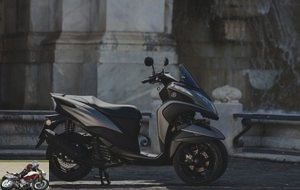
In short: we are less in uncharted territory than in familiar territory. And for 2017, things are changing. The Euro4 standard means BlueCore engine for everyone. The small liquid-cooled 4-stroke single-cylinder has variable valve timing, all to pollute less and respect the planet and baby dolphins. Very good.
In the Tricity, this engine gained 1.2 horsepower, to now deliver 12.2 at 7,500 rpm. The torque is slightly increased, with 11.7 Nm at 7250 rpm.
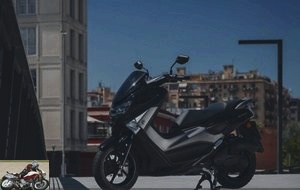
Besides this engine, it is the Tricity which has evolved the most this year: for more stability, the wheelbase has gained 4 centimeters (to 1350 mm now), the saddle is new, the trunk volume has gained 10%, the rear light is LED and the colors are a little more funky than in the past: there is white and satin blue, a dapper yellow and this gloomy gray that, oddly enough, Yamaha has reserved for us for the test. That’s not all: the rear wheel, still for the sake of stability, has gone from 12 to 13 inches.
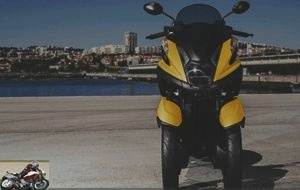
So, 2 or 3 wheels? Let’s say that, especially in certain colors, the Tricity has more whaou factor than the Nmax. It’s already part of the answer.
In the saddle
765 mm for the Nmax, 780 mm for the Tricity. 15cm can make all the difference sometimes. Except that the three-wheeler is a little narrower in the front part of its saddle and that the floor is flatter than that of the Nmax. Result: 3-wheel advantage, unless, of course, verticality is a challenging concept for you.
Once on board, it makes sense. Digital dashboard in both cases, more stylish on the 3 wheels (the strip is wider), but no less complete on the Nmax, which even displays an average consumption indicator. The Tricity prefers to tell you when you need to go to a Yamaha dealership for an oil change or a belt change..
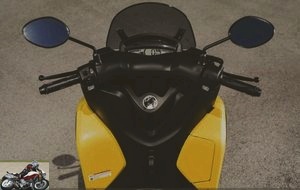
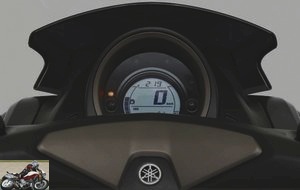
In the city
What do we ask for in town? Maneuverability? Of liveliness? Capacity? So let’s go in order: both are manageable. The Nmax is super agile and the Tricity is very agile. Small difference, but real. We quickly end up forgetting the weight of the front axle of the Tricity, while we turn around in a pocket square. Nevertheless, in super congested urban conditions, the Nmax does better while the Tricity does well, seduced by its naturalness and drives practically like a normal scooter (when nitpicking, we feel a very slight sculling effect linked to the two wheels when driving on bumpy ground, like the cobblestones of Rome, at very low speed, while during extreme maneuvers, you sometimes have to "remind" the direction, a bit like on cars whose assistance would not be good calibrated, putting the wheels back in line after an avoidance). But nothing that is neither difficult to apprehend nor impossible to manage: the fact remains that the Tricity does not have this effect "there’s a bag of cement on the front axle, you take it anyway?" that we know well about MP3 and Metropolis.

Vivacity? We are not dealing here with dragsters, but for urban use, things are going well all the same. Advantage Nmax, however, which has less weight to pull and which even manages to stand up to the Tricity in its 155cc version (not imported in France, but we also had one available during our test in Italy). But whether in acceleration or in times, the 2 wheels are ahead of the 3.
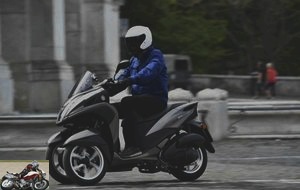
Capacity? The boxes under the saddle are the correct size, without being exceptional, but in both cases, do you fit a full-face helmet? Equality, then? No, because the flat floor of the Tricity can accommodate a little more.
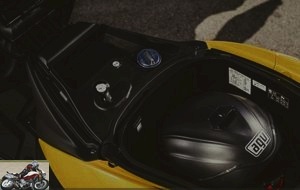
Suddenly, we are 2 against 1 to the advantage of Tmax. And the Tricity regains half a point, because it is more stable when crossing tram rails, for example, and gains one more point for its comfort, because the damping of the Nmax is simply deplorable on cobblestones..
Against all odds: Tricity victory, so !
On highways and main roads
It’s simple: between the Colosseum and the Vatican, we haven’t seen any! In performance, the Nmax goes a little faster to accelerate to "average" speeds (let’s talk about times between 50 and 80 km / h) which can be an argument to feel at ease between cars and trucks. , even if it will always be a bit borderline. The Tricity is more stable, however. Equality, but let’s not forget that these scooters have above all an urban vocation.
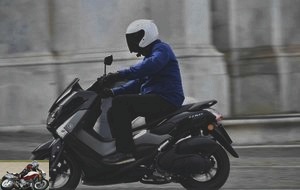
On departmental
These machines are rather planned for the city, but they will not disdain to engage on the small roads to go to the secondary house. In this game, liveliness in Nmax, stability in Tricity: equality.
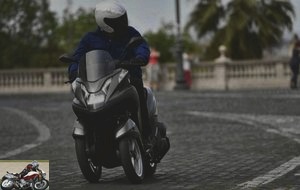
Part-cycle
One more wheel and a more complicated front axle kinematics, it’s 37 kilos of difference. You can feel them when you try to lay the Tricity on its side, to see what would constitute the limit of the ground clearance. But what makes journalists laugh seldom touches the minds of clients and, in addition to the weight, it is also its distribution that matters. The strength of the Tricity is to keep a real feeling of lightness despite its particular kinematics. In fact, it’s simple, we quickly forget that we have two front wheels.
Brakes
Equality at the rear, with a 230 mm disc. Advantage Tricity at the front, with two 220 mm discs against only one of 230 for the Nmax. And yet, the 2-wheel scooter brakes better, with a better feeling. Nmax advantage.
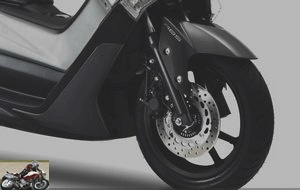

Important clarification: for the 125, the legislator asks that the braking be, as desired, equipped with an ABS or a coupling. Originally, the Nmax comes with ABS as standard. Regarding the Tricity, on the other hand, it is a series coupled braking, called UBS. ABS is available at an additional cost.
Comfort and duo
Angry subject: on the cobblestones of Rome, which certainly represent an extreme configuration in terms of coating, the Nmax has unveiled its dark side: an absolutely deplorable rear damping. The Tricity does not yet speak to perfection, but it is much less worse.
Regarding the Nmax, we can retort that this character trait is common to many entry-level scooters. Certainly, but yet, within the Yamaha range, the more affordable D’elight does better. It is therefore not inevitable.
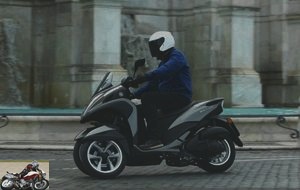
Consumption & autonomy
In Rome, the Nmax had an average consumption of 3.2 l / 100 on its dashboard, which is good, because we didn’t really do any contemplative cruising. The Tricity did not tell us about its value: too bad for him. He loses the point, stupidly.
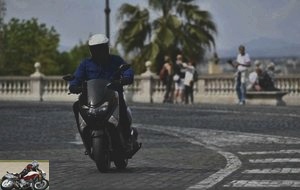
Practical aspects
It’s correct in both cases, with a carrying capacity that offers the minimum vital: a helmet, a lock, rain pants, all of that goes (inside). The Tricity, however, does better with its flat floor and its hook on the front apron. Let us not forget that it does not have a front axle lock like the MP3s and others: it must therefore be crutched, preferably on the central, but it is very easy. If you notice the presence of a parking brake at the bottom left of the handlebars, it means that you are on the Tricity 155.
Conclusion
You might think that a three-wheeled scooter only serves to reassure those who are cautious about the trajectory and those worried about balance. It is true that this is their main argument. But by counting all the points, we see that it loses a little in agility and performance (being heavier with the same engine, that’s normal), but that it turns out to be more stable and more comfortable, but also more practical. . And that, ultimately, it could weigh in the balance as much as the price difference is reasonable, since faced with an Nmax posted 3199 €, the UBS Tricity is at 3999 €, which is downright well placed, while the Tricity ABS is € 4,499.
And as it presents a little better, that also counts.
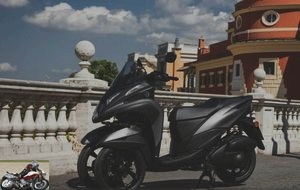
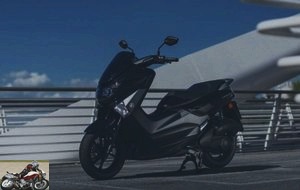
Warning: the table below puts the comparative advantages of a Tricity compared to an Nmax in perspective..
Strong points
- Stability
- Front axle which is forgotten
- Ease of driving
- Fairly complete equipment
- Excellent turning radius
- Better cushioning
Weak points
- Slightly heavier, but never really bothersome
- A little less flamboyant performance (acceleration)
- Higher price, necessarily
The technical sheet of the Yamaha Nmax
The Yamaha Tricity technical sheet
Test conditions
- Itinerary: 40 km in Rome (it’s not much, but it counts three times given the traffic and the cobblestones)
- Motorcycle mileage: 300 km
- Problem encountered: having to buy back some vertebrae because of the cobblestones! But it’s beautiful, Rome !
The Yamaha Tricity video test
Related articles
-
MP3 killer? 5 day trial… Xmax Blu-Core single cylinder, UBS full braking, 14 wheels, Bridgestone tires, Smart Key, tilt lock… How to give confidence…
-
The three-wheeler at a low price Three-wheeled scooters have experienced tremendous growth, especially in France since the appearance of the Piaggio MP3…
-
Yamaha TMAX Hyper Modified scooter test
Mad MAX ‘Supermot’ Scoot ! Scooters are convenient, motorcycles are fun. One offers utilitarian transportation, the other excitement and thrills. But by…
-
Yamaha Majesty 400 ABS scooter test
The big scooter signed Yamaha Appeared in 2004, modified in 2005, the Majesty 400 is a large urban scooter, less sporty than the TMax but faster than a…
-
Mini-size, maxi-pleasure Who would have said that a 125 cm3 mini scooter had its place in France? We were used to aggressive scooters with small wheels….
-
Yamaha Xmax 300 Iron Max scooter test
Unlimited version of the tuning fork maxiscoot Leather, seat with backrest, aluminum footrest, specific color… A scooter is always worth less than the…
-
Yamaha Xenter 125 scooter test
Uncommon in France but popular in Italy, the Xenter is in line with the Honda SH 125 and other MBK Oceo, Peugeot Vivacity and Piaggio Liberty ……
-
Comparison test of the Yamaha YZF-R1 and R1M
The easy missile Euro5, 4 cylinders 998 cm3, 200 hp and 113.3 Nm, 201 kg full made, from € 19,299 Each brand has its legendary hyper-sport, its…
-
Double-dealing ! Long announced, the Yamaha YZF-R3 Yamaha is finally out of the woods and completes the sport range of the Japanese manufacturer, halfway…
-
A tri-wheeler called pleasure Three cylinders, 4T, 84.6 kW (115.0 hp), 87.5 N.m (8.9 m.kgf), 263 kg, 14,999 euros With the arrival in 2006 of the MP3…